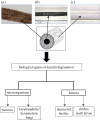Interpreting biological degradative processes acting on mammalian hair in the living and the dead: which ones are taphonomic?
- PMID: 25339725
- PMCID: PMC4213647
- DOI: 10.1098/rspb.2014.1755
Interpreting biological degradative processes acting on mammalian hair in the living and the dead: which ones are taphonomic?
Abstract
Although the taphonomic (post-mortem) degradation processes relevant to teeth and bones have been well described, those taking place with regards to mammalian hairs have not been characterized to the same extent. This present article describes, in detail, microscopic changes resulting from the actions of biological agents that digest and degrade hairs. The most noteworthy and prevalent agents responsible for the destruction of hair structure are fungi, which use a range of strategies to invade and digest hairs. One of the most important finds to emerge from this study is that taphonomic structures and processes can easily be interpreted by the unwary as 'real', or as class characteristics for a particular animal taxon. Moreover, under certain conditions, 'taphonomic' processes normally associated with the dead are also present on the hairs of the living. This work will improve the reliability of hair examinations in forensic, archaeological and palaeontological applications-in addition, the finding has relevance in the protection of mammalian collections susceptible to infestation. This article also addresses the popular myth that ancient peoples were often red-haired and discusses phenomena responsible for this observation. Insights gained from detailed characterization of taphonomic processes in 95 hairs from a variety of species demonstrate the range and breadth of degradative effects on hair structure and colour. Lastly, the study demonstrates that hairs often tell a story and that there is value of extracting as much morphological data as possible from hairs, prior to destructive sampling for biomolecules.
Keywords: archaeology; forensic investigations; mammalian hairs; microscopy; taphonomy.
© 2014 The Author(s) Published by the Royal Society. All rights reserved.
Figures





Similar articles
-
Fine structure and immunocytochemistry of monotreme hairs, with emphasis on the inner root sheath and trichohyalin-based cornification during hair evolution.J Morphol. 2004 Sep;261(3):345-63. doi: 10.1002/jmor.10254. J Morphol. 2004. PMID: 15281062
-
Fine structure of marsupial hairs, with emphasis on trichohyalin and the structure of the inner root sheath.J Morphol. 2004 Sep;261(3):390-402. doi: 10.1002/jmor.10257. J Morphol. 2004. PMID: 15281065
-
[Species determination of mammals based on the hair cuticle pattern--a comparison of domestic mammals and their wild ancestors from the forensic viewpoint].Arch Kriminol. 1997 Jul-Aug;200(1-2):45-55. Arch Kriminol. 1997. PMID: 9382690 German.
-
Forensic Human Hair Examination and Comparison in the 21st Century.Forensic Sci Rev. 2005 Jan;17(1):51-66. Forensic Sci Rev. 2005. PMID: 26257110 Review.
-
Examination, Analysis, and Application of Hair in Forensic Science - Animal Hair.Forensic Sci Rev. 2005 Jan;17(1):17-28. Forensic Sci Rev. 2005. PMID: 26257108 Review.
Cited by
-
25-Hydroxyvitamin D Measurement in Human Hair: Results from a Proof-of-Concept study.Nutrients. 2019 Feb 18;11(2):423. doi: 10.3390/nu11020423. Nutrients. 2019. PMID: 30781610 Free PMC article.
-
Progress in Microbial Degradation of Feather Waste.Front Microbiol. 2019 Dec 5;10:2717. doi: 10.3389/fmicb.2019.02717. eCollection 2019. Front Microbiol. 2019. PMID: 31866957 Free PMC article. Review.
-
Unlocking the Potential of Animal Hair Shafts for Genomic Studies: A Comprehensive Evaluation of DNA Quality.Biology (Basel). 2025 Mar 28;14(4):353. doi: 10.3390/biology14040353. Biology (Basel). 2025. PMID: 40282218 Free PMC article.
References
-
- Appleyard HM. 1978. Guide to the identification of animal fibres. Leeds, UK: Wool Industries Research Association (WIRA).
-
- Rowe WF. 2010. Extreme degradation of human hair by keratinophilic and kertinolytic fungi. Microscope 58, 115–119.
-
- Teerink BJ. 1991. Hair of west European mammals: atlas and identification key, p. 221 New York, NY: Cambridge University Press.
-
- Lyman RL. 2010. What taphonomy is, what it isn't, and why taphonomists should care about the difference. J. Taphonomy 8, 17.
Publication types
MeSH terms
Substances
LinkOut - more resources
Full Text Sources
Other Literature Sources

